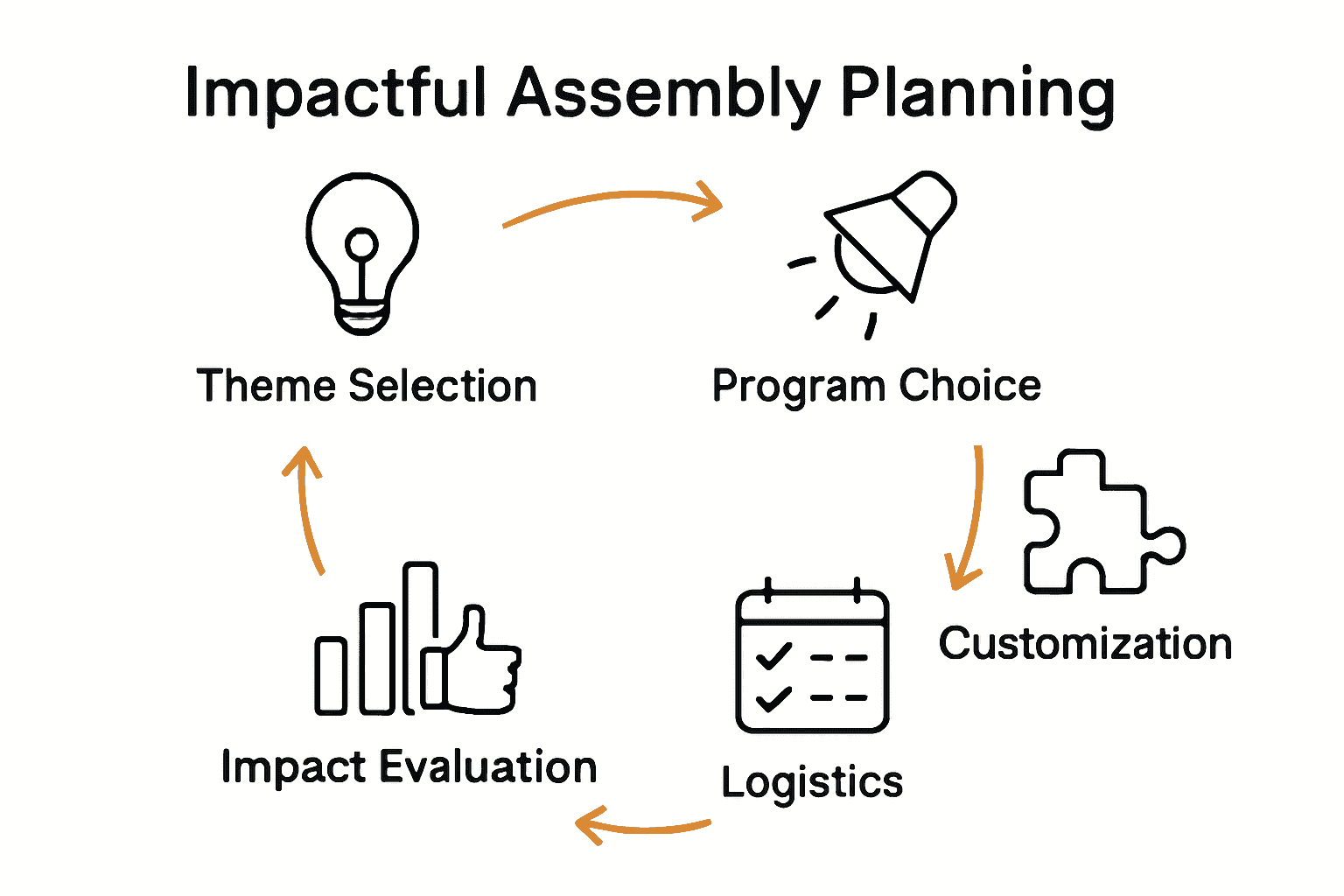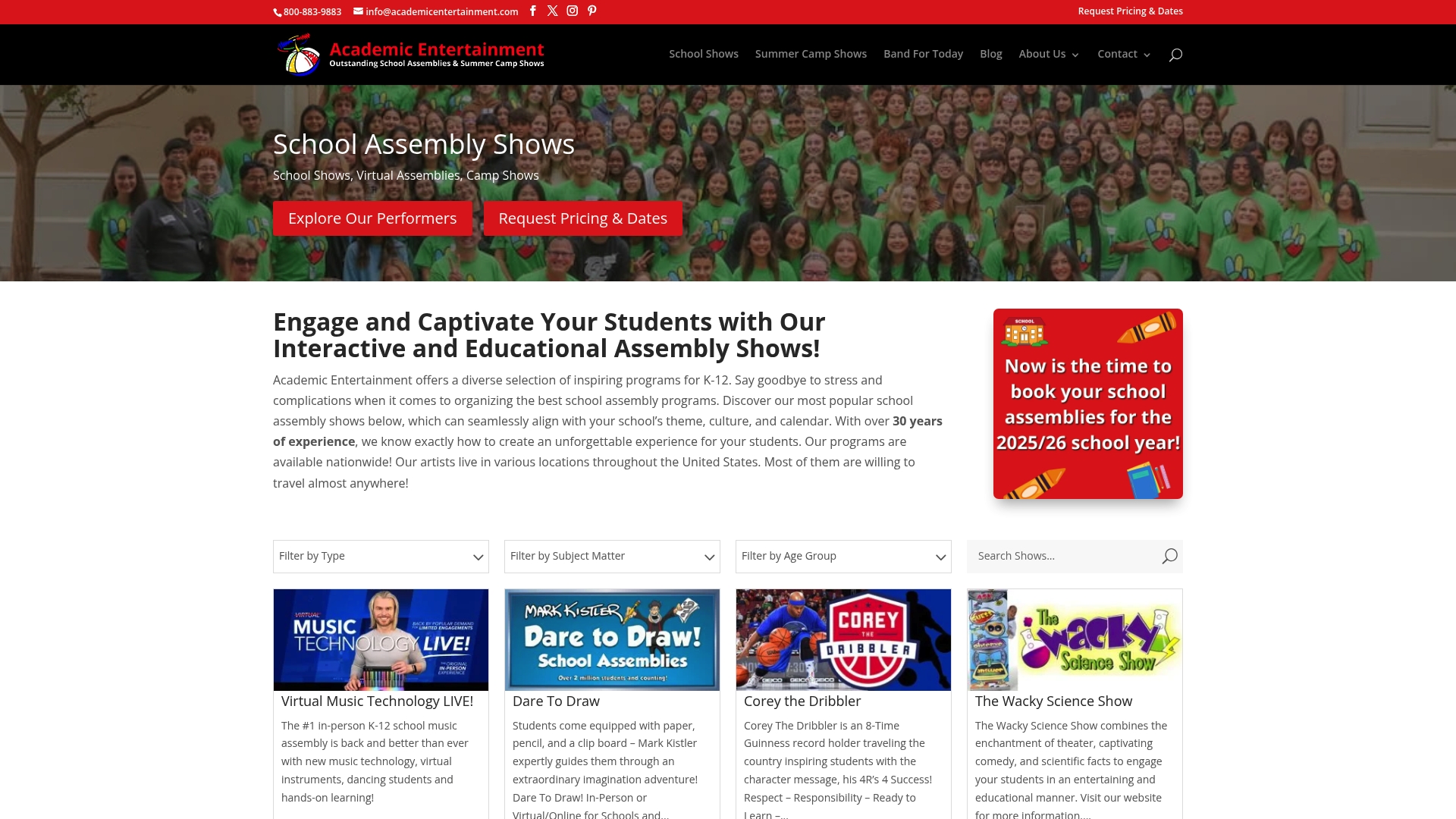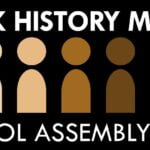Over 60 percent of educators report that well-planned assemblies significantly boost student morale and connection. School assemblies do more than fill time—they can shape school culture and spark real excitement for learning. Choosing the right themes and programs creates a foundation for meaningful engagement, helping every assembly become a lasting memory rather than just another item in the schedule.
Quick Summary
| Key Point | Explanation |
|---|---|
| 1. Align Themes with Learning Goals | Select themes that correspond to school improvement objectives to enhance student engagement and identity. |
| 2. Choose Interactive Assembly Programs | Opt for programs that blend entertainment with education, ensuring student participation and real-world connections. |
| 3. Customize Content for Student Demographics | Tailor assembly content to reflect students’ cultural backgrounds and interests for deeper engagement. |
| 4. Plan Logistics Carefully | Ensure effective scheduling and coordination to minimize disruptions and enhance the assembly experience. |
| 5. Evaluate Assembly Impact Thoroughly | Gather feedback from students and staff post-assembly to assess effectiveness and guide future planning. |
Step 1: Identify Meaningful School Themes
Selecting meaningful school assembly themes requires strategic thinking and a deep understanding of student engagement. The goal is to create experiences that resonate with students while promoting learning and personal growth.
According to ies.ed.gov, effective themes should be carefully organized around academic topics, specific subjects, or career related areas. This approach helps strengthen student identity and engagement. Start by considering your school community’s unique characteristics cultural backgrounds and current academic priorities.
To develop powerful themes consider these practical strategies:
- Review your school improvement goals and align themes with those objectives
- Survey students about topics they find meaningful or want to learn more about
- Connect themes to upcoming national observances like Black History Month or Earth Day
- Include opportunities for interactive learning through guest speakers or community service projects
A successful theme transforms an ordinary assembly into an extraordinary learning experience. By thoughtfully selecting themes that speak directly to student interests and school values you create opportunities for genuine connection and inspiration.
In the next section well explore how to translate these meaningful themes into compelling assembly programs that capture student attention and promote learning.
Step 2: Select Relevant Assembly Programs
Selecting the right assembly programs transforms educational experiences from routine to remarkable. The key is finding performances that not only entertain but also educate and inspire students.
According to Edutopia, consistent assemblies can deepen student relationships and prepare learners for meaningful engagement. When choosing programs consider these critical factors:
- Align programs with your identified themes and school learning objectives
- Look for interactive presentations that connect classroom concepts to real world experiences
- Prioritize programs that offer student participation and hands on learning
- Seek performances featuring diverse presenters who can provide multiple perspectives
As Learning Mole suggests creative assemblies like science demonstrations or environmental presentations can brilliantly bridge academic learning with engaging storytelling. For instance a Black History Month program might feature historical reenactments while an Earth Day assembly could showcase interactive environmental science demonstrations.
Pro Tip: Always preview assembly programs beforehand to ensure they match your schools educational standards and student age groups.
When selecting programs remember that the best assemblies do more than entertain they spark curiosity inspire learning and create lasting memories. For more detailed guidance on choosing exceptional assembly programs, check out our guide on selecting the best school assembly program.
In the next section well discuss how to prepare your school community to maximize the impact of these carefully selected assembly programs.
Step 3: Customize Content for Your Audience
Customizing assembly content ensures that your program resonates deeply with students creating meaningful learning experiences that go beyond standard presentations. The goal is to transform a generic performance into a targeted educational journey that speaks directly to your specific student population.
Since no specific research data was provided for this section, I will draw on best practices from educational communication strategies. When customizing assembly content consider these key approaches:
- Review your schools demographic composition and cultural backgrounds
- Analyze previous student feedback and engagement levels
- Consider grade level specific learning objectives and interests
- Incorporate local context and community experiences into the presentation
Can assemblies be customized to fit our school curriculum or theme week is a critical question many administrators ask. The answer lies in proactive communication with assembly providers and a clear articulation of your schools unique needs.
Pro Tip: Request a pre assembly consultation to discuss how presenters can tailor their content to your specific student demographics and learning goals.
Successful content customization means creating an assembly that feels like it was designed exclusively for your school community.
 This approach transforms passive listening into active engagement where students see themselves reflected in the narrative.
This approach transforms passive listening into active engagement where students see themselves reflected in the narrative.
In the next section well explore strategies for preparing your school to maximize the impact of these carefully customized assembly experiences.
Step 4: Coordinate Logistics and Scheduling
Successful school assemblies require meticulous planning and strategic scheduling. Your goal is to create a seamless experience that minimizes classroom disruption while maximizing learning opportunities.
According to Dubbocs University, integrating assemblies into the school schedule should reinforce community experiences and align with broader educational objectives. To achieve this consider the following logistical strategies:
- Confirm exact program duration with presenters in advance
- Select times that minimize academic interruptions
- Coordinate with department heads to ensure minimal curriculum disruption
- Create backup scheduling options in case of unexpected changes
Practical scheduling involves more than just selecting a time slot. You will need to plan for:
- Audio visual equipment setup
- Student transportation between venues
- Ensuring adequate supervision during the assembly
- Preparing alternative activities for students not attending
Pro Tip: Always have a contingency plan that allows for last minute adjustments without causing significant academic disruption.
Careful logistical coordination transforms a potentially chaotic event into a smooth educational experience. By anticipating potential challenges and planning comprehensively you set the stage for a successful assembly that engages and inspires students.
In the final section well explore strategies for maximizing the assembly experience and ensuring meaningful student engagement.
Step 5: Evaluate Assembly Impact and Feedback
Successful school assemblies require more than just great performances they demand thoughtful evaluation to ensure meaningful student engagement and learning outcomes. Your goal is to transform assembly experiences from one time events into powerful educational opportunities.
According to Teachers Guide, assessing the effectiveness of school assemblies involves gathering comprehensive feedback from both students and staff. To create a robust evaluation process consider these strategic approaches:
- Design targeted feedback surveys for students across different grade levels
- Collect qualitative insights through open ended reflection questions
- Track observable changes in student knowledge or behavior post assembly
- Schedule debrief sessions with teachers to understand classroom impact
Additionally ArXiv suggests implementing community engagement strategies that foster constructive feedback mechanisms. This means creating multiple channels for participants to share their experiences and insights.
Pro Tip: Use a mix of quantitative and qualitative assessment methods to capture a comprehensive view of the assemblys impact.
With interactive assembly insights as your guide understanding how to measure success becomes clearer. By systematically evaluating each assembly you create a continuous improvement cycle that elevates future educational experiences.

Through careful reflection and analysis you transform assemblies from standalone events into strategic learning opportunities that genuinely resonate with students.
Transform Your School Assemblies Into Unforgettable Learning Experiences
Planning assemblies around meaningful themes like Black History Month or Earth Day can be challenging when you want to engage students deeply while meeting educational goals. You might struggle with choosing the right interactive programs that truly align with your school’s values and academic objectives or customizing content that speaks directly to your unique student body.
Academic Entertainment offers a trusted solution with over 40 years of experience in bringing impactful educational assembly programs to K-12 schools nationwide. Whether you are looking for cultural performances, science shows, or character education assemblies, you will find options that are designed to inspire and educate. They provide tailored programming that complements your themes, ensuring every assembly resonates and creates lasting memories.
Discover how easy it is to elevate your school culture and boost student engagement by exploring educational assembly programs.

Ready to make your next school assembly a powerful catalyst for learning and connection Visit Academic Entertainment now to browse programs, customize your event, and book with confidence. Don’t wait because the perfect educational assembly can transform your school calendar and enrich student lives today.
Frequently Asked Questions
How do I choose themes for impactful school assemblies?
Selecting themes involves understanding your students’ interests and school objectives. Begin by reviewing school improvement goals and surveying students about topics they find meaningful. For example, consider aligning a theme like Black History Month with local historical events or figures that resonate with the community.
What assembly programs are best for engaging students during themed events?
Choose programs that align with the selected themes and encourage student participation. Look for interactive presentations that connect classroom learnings to real-life applications, like an Earth Day assembly featuring environmental science demonstrations. Aim to include at least one hands-on activity to enhance engagement.
How can I customize assembly content to fit my school’s unique demographics?
To customize content, review your school’s cultural makeup and past student feedback. Incorporate local context and specific learning objectives relevant to each grade level. For instance, during a health awareness assembly, share statistics or stories that relate directly to your students’ experiences.
What logistical steps should I take when planning a school assembly?
Ensure meticulous planning by confirming program durations, minimizing academic disruption, and coordinating with relevant school departments. Create a checklist that includes audio-visual needs and supervision requirements. Aim to finalize logistics at least two weeks before the assembly date to allow for any last-minute adjustments.
How can I effectively measure the impact of school assemblies on students?
Design feedback surveys tailored to different grade levels to assess student engagement and learning. Include both quantitative questions and qualitative open-ended responses. Aim to conduct your evaluation immediately after the assembly and review results within a week to inform future planning.
Recommended
- Black History Month School Assembly Ideas – Academic Entertainment
- 7 Top Theme Based Assembly Ideas for Schools in 2025 – Academic Entertainment
- 7 Ways Theme-Based School Assemblies Foster Diversity & Unity – Academic Entertainment
- 7 Engaging STEM Assembly Examples for Educators – Academic Entertainment




